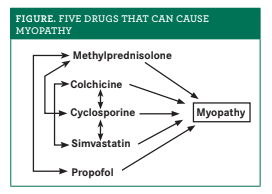Myopathy From Colchicine and Statins
Myopathy is a well-established adverse outcome of statin use, and the muscle damage can range from minor muscle pain and weakness to life-threatening rhabdomyolysis. Statin-induced myopathy often occurs and is the result of increased statin plasma concentrations caused by interacting drugs, usually inhibitors of CYP3A4. For some statin drug interactions, other mechanisms may also be involved.
Colchicine can also produce myopathy, and rhabdomyolysis has been reported in severe cases. As with statins, muscle damage often occurs when CYP3A4 inhibitors cause large increases in colchicine plasma concentrations. Given that both colchicine and statins can cause myopathy individually, health care professionals might expect that the combination of statins and colchicine would increase the risk. Numerous credible case reports published over the past 2 decades do suggest that the combination of colchicine and statins may increase the risk of myopathy compared with either drug alone.1-15
Adverse Outcomes
In cases of myopathy in patients receiving colchicine and a statin, muscle weakness was the most common finding, occurring in virtually every case. In some cases, the weakness was so severe that the patient could not even stand up. In about one-third of the cases, muscle weakness was accompanied by muscle pain. Darkening of the urine to a tea-colored hue also sometimes accompanied the physical symptoms.
The onset of the symptoms usually occurred after 2 to 3 weeks of combined therapy, but in some cases, the patient noticed changes after about a week. Occasionally, there was a latent period of 2 to 3 months or more. This is important to note because clinicians may not have a high index of suspicion about something that occurred months previously.
Prevalence
A study of statin-induced myopathy found that 40% of the patients received a drug that may have predisposed them to the muscle damage, and colchicine was the second-most-common interacting drug.15 A more recent report focusing only on simvastatin drug—drug interactions (DDIs) reported that the combination with colchicine was the second-most-common DDI exposure, after gemfibrozil.
Case Report
One remarkable case of fatal rhabdomyolysis involving colchicine and simvastatin is instructive.5 A 66-year-old man presented with muscle weakness so severe that he had trouble walking and getting up from a chair. His medications were colchicine 1.2 mg per day, cyclosporine 150 mg per day, mycophenolate 500 mg per day, prednisone 7.5 mg per day, and simvastatin 60 mg per day. His creatine kinase (CK) was 2538, suggesting myopathy, so the colchicine and simvastatin were stopped, but he was then given intravenous methylprednisolone and propofol. He developed severe rhabdomyolysis with a CK of 33,580 and died 5 days after admission.
The figure shows that he received 5 drugs that can individually cause myopathy (represented by the single arrows) and 5 combinations of drugs that have been associated with myopathy and/or pharmacokinetic DDIs (represented by the double arrows). Although it is impossible to determine which drugs were primarily responsible in this tragic case, the ability of cyclosporine to increase plasma concentrations of colchicine, methylprednisolone, and simvastatin may have played a significant role.

Recommendations:
If it is necessary to give patients colchicine and a sta- tin, use conservative doses of both drugs, if possible. The patient should be advised to immediately report any muscle pain or weakness as well as brownish or darkened urine. The patient is likely to fare better if the myopathy is diagnosed quickly and the drugs are discontinued
John R. Horn, PharmD, FCCP, and Philip D. Hansten, PharmD, are both professors of pharmacy at the University of Washington School of Pharmacy in Seattle. For an electronic version of this article, including references, visit hanstenandhorn.com.
References
1. Hsu W-C, Chen WH, Chang MT, Chiu HC. Colchicine-induced acute myopathy in a patient with concomitant use of simvastatin. Clin Neuropharmacol. 2002;25(5):266-268.
2. Baker SK, Goodwin S, Sur M, Tarnopolsky MA. Cytoskeletal myotoxicity from simvastatin and colchicine. Muscle Nerve.2004;30(6):799-802. doi: 10.1002/mus.20135.
3. Justiniano M, Dold S, Espinoza SR. Rapid onset of muscle weakness (rhabdomyolysis) associated with the combined use of simvastatin and colchicine. J Clin Rheumatol.2007;13(5):266-268. doi: 10.1097/RHU.0b013e318156d977.
4. Sahin G, Korkmaz C, Yalcin AU. Which statin should be used together with colchicine? Clinical experience in three patients with nephrotic syndrome due to AA type amyloidosis. Rheumatol Int.2008;28(3):289-291. doi: 10.1007/s00296-007-0435-1.
5. Francis L, Bonilla E, Soforo E, et al. Fatal toxic myopathy attributed to propofol, methylprednisolone, and cyclosporine after prior exposure to colchicine and simvastatin. Clin Rheumatol.2008;27(1):129-131. doi: 10.1007/s10067-007-0696-9.
6. Tufan A, Dede DS, Cavus S, Altintas ND, Iskit AB, Topeli A. Rhabdomyolysis in a patient treated with colchicine and atorvastatin. Ann Pharmacother. 2006;40(7-8):1466-1469. doi: 10.1345/aph.1H064.
7. Phanish MK, Krishnamurthy S, Bloodworth LL. Colchicine-induced rhabdomyolysis. Am J Med.2003;114(2):166-167.
8. Vasudevan AR, Uthamalingam S, Kumar S, Tamarin F, Brensilver JM. Colchicine-induced rhabdomyolysis: the whole is greater than the sum of its parts! Am J Med.2003;115(3):249.
9. Torgovnick J, Sethi N, Arsura E. Colchicine and HMG Co-A reductase inhibitors induced myopathy—a case report. Neurotoxicology. 2006;27(6):1126-1127. doi: 10.1016/j.neuro.2006.09.003.
10. Atasoyu EM, Evrenkaya TR, Solmazgul E. Possible colchicine rhabdomyolysis in a fluvastatin-treated patient. Ann Pharmacother.2005;39(7-8):1368-1369. doi: 10.1345/aph.1E653.
11. Sarullo FM, Americo L, Di Franco A, Di Pasquale P. Rhabdomyolysis induced by co-administration of fluvastatin and colchicine. Monaldi Arch Chest Dis.2010;74(3):147-149. doi: 10.4081/monaldi.2010.264.
12. Alayi G, Cengiz K, Canturk F, Durmus D, Akyol Y, Menekse EB. Acute myopathy in a patient with concomitant use of pravastatin and colchicine. Ann Pharmacother. 2005;39(7-8):1358-1361. doi: 10.1345/aph.1E593.
13. Bouquié R, Deslandes G, Renaud C, Dailly E, Haloun A, Jolliet P. Colchicine-induced rhabdomyolysis in a heart/lung transplant patient with concurrent use of cyclosporin, pravastatin, and azithromycin. J Clin Rheumatol.2011;17(1):28-30. doi: 10.1097/RHU.0b013e3182056042.
14. Boonmuang P, Nathisuwan S, Chaiyakunapruk N, et al. Characterization of statin-associated myopathy case reports in Thailand using the health product vigilance center database. Drug Saf. 2013;36(9):779-787. doi: 10.1007/s40264-013-0055-5.
15. Siriangkhawut M, Tansakul P, Uchaipichat V. Prevalence of potential drug interactions in Thai patients receiving simvastatin: the causality assessment of musculoskeletal adverse events induced by statin interaction. Saudi Pharm J. 2017;25(6):823-829. doi: 10.1016/j.jsps.2016.12.006.

